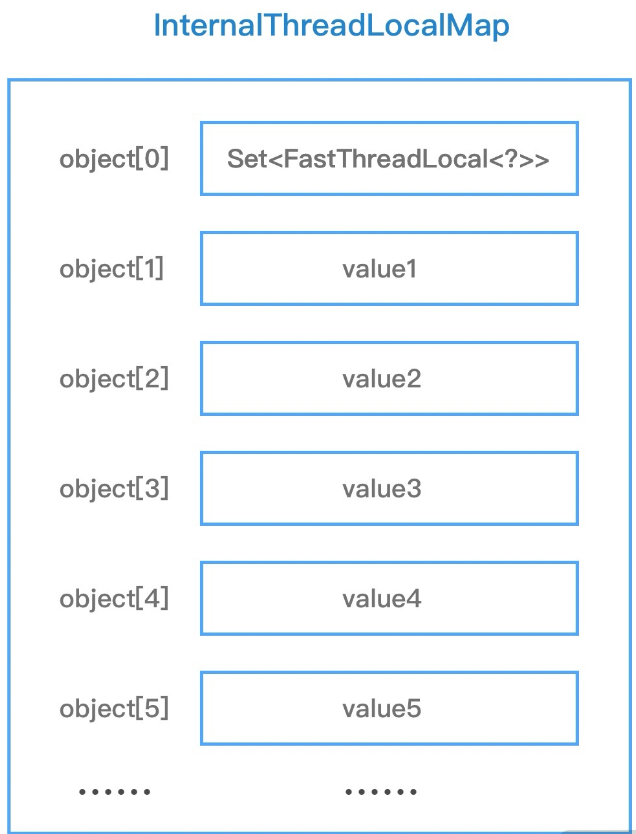FastThreadLocal 为什么快
FastThreadLocal 的实现与 ThreadLocal 非常类似,Netty 为 FastThreadLocal 量身打造了 FastThreadLocalThread 和 InternalThreadLocalMap 两个重要的类。
FastThreadLocalThread 是对 Thread 类的一层包装,每个线程对应一个 InternalThreadLocalMap 实例。只有 FastThreadLocal 和 FastThreadLocalThread 组合使用时,才能发挥 FastThreadLocal 的性能优势。
FastThreadLocalThread 的源码:
1 | public class FastThreadLocalThread extends Thread { |
可以看出 FastThreadLocalThread 主要扩展了 InternalThreadLocalMap 字段,我们可以猜测到 FastThreadLocalThread 主要使用 InternalThreadLocalMap 存储数据,而不再是使用 Thread 中的 ThreadLocalMap。所以想知道 FastThreadLocalThread 高性能的奥秘,必须要了解 InternalThreadLocalMap 的设计原理。
我们知道 ThreadLocal 的一个重要缺点,就是 ThreadLocalMap 采用线性探测法解决 Hash 冲突使得性能较慢,那么 InternalThreadLocalMap 又是如何优化的呢?首先一起看下 InternalThreadLocalMap 的内部构造。
1 | public final class InternalThreadLocalMap extends UnpaddedInternalThreadLocalMap { |
通过源码可以看出,InternalThreadLocalMap 与 ThreadLocalMap 一样都是采用数组的存储方式。
但是 InternalThreadLocalMap 并没有使用线性探测法来解决 Hash 冲突,而是在 FastThreadLocal 初始化的时候分配一个数组索引 ,index 的值采用原子类 AtomicInteger 保证顺序递增,通过调用 InternalThreadLocalMap.nextVariableIndex() 方法获得。然后在读写数据的时候通过数组下标 index 直接定位到 FastThreadLocal 的位置,时间复杂度为 O(1)。
如果数组下标递增到非常大,那么数组也会比较大,所以 FastThreadLocal 是通过空间换时间的思想提升读写性能。下面通过一幅图描述 InternalThreadLocalMap、index 和 FastThreadLocal 之间的关系。

对比 ThreadLocal , FastThreadLocal 使用 Object 数组替代了 Entry 数组,Object[0] 存储的是一个Set<FastThreadLocal<?>> 集合,从数组下标 1 开始都是直接存储的 value 数据,不再采用 ThreadLocal 的键值对形式进行存储。
FastThreadLocal 源码分析
FastThreadLocal 的示例代码:
1 | public class FastThreadLocalTest { |
FastThreadLocal 的使用方法几乎和 ThreadLocal 保持一致,只需要把代码中 Thread、ThreadLocal 替换为 FastThreadLocalThread 和 FastThreadLocal 即可。
FastThreadLocal.set()
首先给出 set 方法的源码:
1 | public final void set(V value) { |
FastThreadLocal.set() 方法虽然入口只有几行代码,但是内部逻辑是相当复杂的。我们首先还是抓住代码主干,一步步进行拆解分析。set() 的过程主要分为三步:
- 判断 value 是否为缺省值,如果等于缺省值,那么直接调用 remove() 方法。这里我们还不知道缺省值和 remove() 之间的联系是什么,我们暂且把 remove() 放在最后分析。
- 如果 value 不等于缺省值,接下来会获取当前线程的 InternalThreadLocalMap。
- 然后将 InternalThreadLocalMap 中对应数据替换为新的 value。
InternalThreadLocalMap.get()
首先我们看下 InternalThreadLocalMap.get() 方法,源码如下:
1 | public static InternalThreadLocalMap get() { |
InternalThreadLocalMap.get() 逻辑很简单,如果当前线程是 FastThreadLocalThread 类型,那么直接通过 fastGet() 方法获取 FastThreadLocalThread 的 threadLocalMap 属性即可。如果此时 InternalThreadLocalMap 不存在,直接创建一个返回。
关于 InternalThreadLocalMap 的初始化在上文中已经介绍过,它会初始化一个长度为 32 的 Object 数组,数组中填充着 32 个缺省对象 UNSET 的引用。
而如果当前线程不是 FastThreadLocalThread 类型,则会调用 slowGet() 方法来获取。当嵌线程不是FastThreadLocalThread 类型时,线程内部是没有 InternalThreadLocalMap 属性的,Netty 在 UnpaddedInternalThreadLocalMap 中保存了一个 JDK 原生的 ThreadLocal,ThreadLocal 中存放着 InternalThreadLocalMap,此时获取 InternalThreadLocalMap 就退化成 JDK 原生的 ThreadLocal 获取。
获取 InternalThreadLocalMap 的过程已经讲完了,下面看下 setKnownNotUnset() 如何将数据添加到 InternalThreadLocalMap 的。
setKnownNotUnset()
方法源码:
1 | private void setKnownNotUnset(InternalThreadLocalMap threadLocalMap, V value) { |
setKnownNotUnset() 主要做了两件事:
- 找到数组下标 index 位置,设置新的 value。
- 将 FastThreadLocal 对象保存到待清理的 Set 中。
首先我们看下第一步 threadLocalMap.setIndexedVariable() 的源码实现:
1 | public boolean setIndexedVariable(int index, Object value) { |
indexedVariables 就是 InternalThreadLocalMap 中用于存放数据的数组,如果数组容量大于 FastThreadLocal 的 index 索引,那么直接找到数组下标 index 位置将新 value 设置进去,事件复杂度为 O(1)。在设置新的 value 之前,会将之前 index 位置的元素取出,如果旧的元素还是 UNSET 缺省对象,那么返回成功。
如果数组容量不够了怎么办呢?InternalThreadLocalMap 会自动扩容,然后再设置 value。接下来看看 expandIndexedVariableTableAndSet() 的扩容逻辑:
1 | private void expandIndexedVariableTableAndSet(int index, Object value) { |
上述代码的位移操作是不是似曾相识?我们去翻阅下 JDK HashMap 中扩容的源码,其中有这么一段代码:
1 | static final int tableSizeFor(int cap) { |
可以看出 InternalThreadLocalMap 实现数组扩容几乎和 HashMap 完全是一模一样的。InternalThreadLocalMap 以 index 为基准进行扩容,将数组扩容后的容量向上取整为 2 的次幂。然后将原数组内容拷贝到新的数组中,空余部分填充缺省对象 UNSET,最终把新数组赋值给 indexedVariables。
为什么 InternalThreadLocalMap 以 index 为基准进行扩容,而不是原数组长度呢?假设现在初始化了 70 个 FastThreadLocal,但是这些 FastThreadLocal 从来没有调用过 set() 方法,此时数组还是默认长度 32。当第 index = 70 的 FastThreadLocal 调用 set() 方法时,如果按原数组容量 32 进行扩容 2 倍后,还是无法填充 index = 70 的数据。所以使用 index 为基准进行扩容可以解决这个问题,但是如果 FastThreadLocal 特别多,数组的长度也是非常大的。
回到 setKnownNotUnset() 的主流程,向 InternalThreadLocalMap 添加完数据之后,接下就是将 FastThreadLocal 对象保存到待清理的 Set 中。我们继续看下 addToVariablesToRemove() 是如何实现的。
1 | private static void addToVariablesToRemove(InternalThreadLocalMap threadLocalMap, FastThreadLocal<?> variable) { |
variablesToRemoveIndex 是采用 static final 修饰的变量,在 FastThreadLocal 初始化时 variablesToRemoveIndex 被赋值为 0。InternalThreadLocalMap 首先会找到数组下标为 0 的元素,如果该元素是缺省对象 UNSET 或者不存在,那么会创建一个 FastThreadLocal 类型的 Set 集合,然后把 Set 集合填充到数组下标 0 的位置。如果数组第一个元素不是缺省对象 UNSET,说明 Set 集合已经被填充,直接强转获得 Set 集合即可。这就解释了 InternalThreadLocalMap 的 value 数据为什么是从下标为 1 的位置开始存储了,因为 0 的位置已经被 Set 集合占用了。
为什么 InternalThreadLocalMap 要在数组下标为 0 的位置存放一个 FastThreadLocal 类型的 Set 集合呢?这时候我们回过头看下 remove() 方法。
remove()
方法源码:
1 | public final void remove() { |
在执行 remove 操作之前,会调用 InternalThreadLocalMap.getIfSet() 获取当前 InternalThreadLocalMap。有了之前的基础,理解 getIfSet() 方法就非常简单了,如果是 FastThreadLocalThread 类型,直接取 FastThreadLocalThread 中 threadLocalMap 属性。如果是普通线程 Thread,从 ThreadLocal 类型的 slowThreadLocalMap 中获取。
找到 InternalThreadLocalMap 之后,InternalThreadLocalMap 会从数组中定位到下标 index 位置的元素,并将 index 位置的元素覆盖为缺省对象 UNSET。接下来就需要清理当前的 FastThreadLocal 对象,此时 Set 集合就派上了用场,InternalThreadLocalMap 会取出数组下标 0 位置的 Set 集合,然后删除当前 FastThreadLocal。
最后 onRemoval() 方法起到什么作用呢?Netty 只是留了一处扩展,并没有实现,用户需要在删除的时候做一些后置操作,可以继承 FastThreadLocal 实现该方法。
FastThreadLocal.get()
方法源码:
1 | public final V get() { |
首先根据当前线程是否是 FastThreadLocalThread 类型找到 InternalThreadLocalMap,然后取出从数组下标 index 的元素,如果 index 位置的元素不是缺省对象 UNSET,说明该位置已经填充过数据,直接取出返回即可。如果 index 位置的元素是缺省对象 UNSET,那么需要执行初始化操作。可以看到,initialize() 方法会调用用户重写的 initialValue 方法构造需要存储的对象数据,如下所示。
1 | private final FastThreadLocal<String> threadLocal = new FastThreadLocal<String>() { |
构造完用户对象数据之后,接下来就会将它填充到数组 index 的位置,然后再把当前 FastThreadLocal 对象保存到待清理的 Set 中。添加的过程和之前一致,不再赘述。
总结
到此为止,FastThreadLocal 最核心的两个方法 set()/get() 已经分析完了。下面有两个问题我们再深入思考下。
- FastThreadLocal 真的一定比 ThreadLocal 快吗?答案是不一定的,只有使用FastThreadLocalThread 类型的线程才会更快,如果是普通线程反而会更慢。
- FastThreadLocal 会浪费很大的空间吗?虽然 FastThreadLocal 采用的空间换时间的思路,但是在 FastThreadLocal 设计之初就认为不会存在特别多的 FastThreadLocal 对象,而且在数据中没有使用的元素只是存放了同一个缺省对象的引用,并不会占用太多内存空间。
相对于 ThreadLocal,简单总结下 FastThreadLocal 的优势。
- 高效查找。FastThreadLocal 在定位数据的时候可以直接根据数组下标 index 获取,时间复杂度 O(1)。而 JDK 原生的 ThreadLocal 在数据较多时哈希表很容易发生 Hash 冲突,线性探测法在解决 Hash 冲突时需要不停地向下寻找,效率较低。此外,FastThreadLocal 相比 ThreadLocal 数据扩容更加简单高效,FastThreadLocal 以 index 为基准向上取整到 2 的次幂作为扩容后容量,然后把原数据拷贝到新数组。而 ThreadLocal 由于采用的哈希表,所以在扩容后需要再做一轮 rehash。
- 安全性更高。JDK 原生的 ThreadLocal 使用不当可能造成内存泄漏,只能等待线程销毁。在使用线程池的场景下,ThreadLocal 只能通过主动检测的方式防止内存泄漏,从而造成了一定的开销。然而 FastThreadLocal 不仅提供了 remove() 主动清除对象的方法,而且在线程池场景中 Netty 还封装了 FastThreadLocalRunnable,FastThreadLocalRunnable 最后会执行 FastThreadLocal.removeAll() 将 Set 集合中所有 FastThreadLocal 对象都清理掉,
